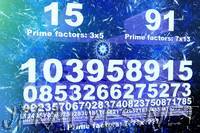
“What are the prime factors, or multipliers, for the number 15? Most grade school students know the answer — 3 and 5 — by memory. A larger number, such as 91, may take some pen and paper. An even larger number, say with 232 digits, can (and has) taken scientists two years to factor, using hundreds of classical computers operating in parallel. Because factoring large numbers is so devilishly hard, this “factoring problem” is the basis for many encryption schemes for protecting credit cards, state secrets, and other confidential data. It’s thought that a single quantum computer may easily crack this problem, by using hundreds of atoms, essentially in parallel, to quickly factor huge numbers. In 1994, Peter Shor, the Morss Professor of Applied Mathematics at MIT, came up with a quantum algorithm that calculates the prime factors of a large number, vastly more efficiently than a classical computer. However, the algorithm’s success depends on a computer with a large number of quantum bits. While others have attempted to implement Shor’s algorithm in various quantum systems, none have been able to do so with more than a few quantum bits, in a scalable way. Now, in a paper published today in the journal Science, researchers from MIT and the University of Innsbruck in Austria report that they have designed and built a quantum computer from five atoms in an ion trap. The computer uses laser pulses to carry out Shor’s algorithm on each atom, to correctly factor the number 15. The system is designed in such a way that more atoms and lasers can be added to build a bigger and faster quantum computer, able to factor much larger numbers. The results, they say, represent the first scalable implementation of Shor’s algorithm.”
